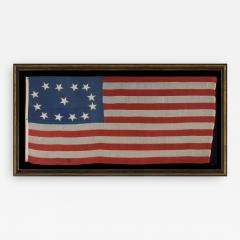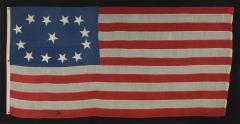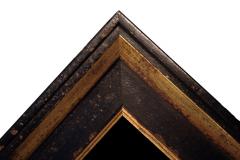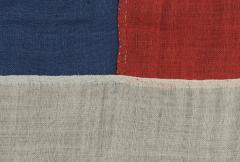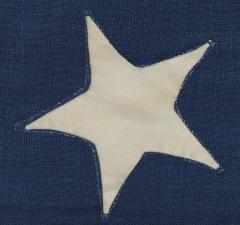Early 13 Star Ship's Flag with an Exceptional, Lopsided Oval Variation
-
Description
EARLY 13 STAR SHIP'S FLAG WITH AN EXCEPTIONAL, LOPSIDED OVAL VARIATION OF THE 3RD MARYLAND PATTERN, CA 1840-1860, AN ENTIRELY HAND-SEWN EXAMPLE WITH BEAUTIFUL FOLK QUALITIES, ONCE BELONGING TO THE LINSLEY & GAY FAMILIES OF CONNECTICUT AND MASSACHUSETTS:
Entirely hand-sewn, 13 star, American national flag, made sometime in the period between 1840 and 1860. The stars, which point in various directions on their vertical axis, are arranged in a flattened oval wreath, with a single, upside-down star in the center. This basic configuration is commonly referred to as the "3rd Maryland" pattern and is very desirable, due to both its attractiveness and the scarcity of its use. The name comes from a flag that was thought to have been present with General Daniel Morgan and the Maryland Light Infantry, carried by Color Sergeant William Batchelor at the battle of Cowpens in 1781. The “Cowpens flag” resides at the Maryland State Capital in Annapolis, but in the 1970’s was discovered to be of Mexican War origin (1846-48) at the earliest.
A similar flag also resides in the collection of the Smithsonian’s National Museum of History & Technology, carried by the Maryland and District of Columbia Battalion of Volunteers during the Mexican War. So the name does have known applicability to another Maryland regiment, but in a period later than the 18th century. In my experience with early flags I have learned that most of the examples with this star configuration that have survived until the present day were made in the 20-year time frame between the Mexican and Civil Wars (1846-1865). For reasons unknown, the design is seldom ever seen in 13 star flags made for the 1876 centennial of our nation’s independence, scarcely 10 years later—a period when 13 star flags were made in relatively large numbers—but it reappears again on a small percentage of 13 star flags made during the 1890-1920 era.
Despite the inherent inaccuracy, the name "3rd Maryland" stuck to the design and is widely used by collectors to describe both circular and oval variations of this basic star pattern.
This particular flag was almost certainly intended for use at sea, possibly as a U.S. Navy small boat ensign. It may otherwise have been used by a commercial ship and the style is often seen in maritime paintings. Surviving examples, however, are few and far between. This one is in nothing short of exceptional condition for the period, with only a small patch in the top, fly end corner, some darning repairs, two small areas of loss in the canton, minor mothing and staining. The overall presentation of the flag is equally exceptional, as the pointy arms of the haphazardly oriented stars lend dramatic folk qualities and visual impact.
The canton and stripes of the flag are made of wool bunting, while the stars are made of cotton and double-appliquéd (applied to both sides of the flag). This is typical construction for the period. There is a sailcloth canvas sleeve with three, sewn, whip-stitched grommets. The entire flag is hand-sewn in all of its elements.
Along the sleeve is a hand-sewn, cloth label that reads “George Gay. 311 Center St.” This would identify one of the flag’s previous owners. The name “Linsley” also appears on the sleeve at the bottom, written rather crudely in large letters. On performing a search on these two names, a match came up in the 1895 “Lineage Book” (v. 12) of the Daughters of the American Revolution, written by their then Historian General, Mary Jane Seymour, and published in Harrisburg, Pennsylvania. The book documents the genealogical history of certain members, among them a Miss Bessie Gay Linsley, born in Connecticut, with Massachusetts and Connecticut lineage. No date of birth is listed for Ms. Linsley, but one might expect than an unmarried woman at this time period might be in her late teens or twenties.
Bessie Gay Linsley was the daughter of Charles Foote Linsley and Georgina Emily Gay. Georgina was the daughter of George Gay and Martha Waters of Massachusetts. So two generations back, coordinating quite perfectly with the probable date of the flag, in a seafaring state, is George Gay, Bessie’s grandfather, the likely original owner of the flag. It seems highly unlikely that these two family names would come together a second time in early America and run back to a George Gay of the right period, in a maritime state. What George Gay did for a profession is unlisted, but his grandfather, Thaddeus Gay, fought in the Revolution, as did many other members of the extended family. So a military past exists, increasing the probability that there would have been family access to a flag of this nature, because Stars & Stripes flags of this period were largely used on ships, military and government buildings. The ability to tie a likely person to a flag of this period is exciting, even if not proven beyond a reasonable doubt, because so few 19th century flags exist where even this much assumed history can be obtained.
Flags made prior to the Civil War are extremely rare, comprising less than one percent of 19th century flags that exist in the 21st century. Prior to the Confederate attack on Fort Sumter in 1861, the Stars & Stripes was simply not used for most of the same purposes we employ it in today. Private individuals did not typically display the flag in their yards and on their porches. Parade flags didn't often fly from carriages and horses. Places of business rarely hung flags in their windows. The only consistent private use prior to 1861 seems to have accompanied political campaigning.
Even the military did not use the national flag in a manner that most people might think. Most people are surprised to learn that the infantry wasn’t authorized to carry the Stars & Stripes until the 1830’s, and even then did not often exercise the right, because it was neither required nor customary. The primary purpose before the Mexican War (1846-48) was to mark ships on the open seas. While the flag was used to mark garrisons and government buildings, the flags of ground troops were often limited to the flag of their own regiment and perhaps a federal standard.
13 star flags have been flown throughout our nation’s history for a variety of purposes. They were hoisted at patriotic events, including Lafayette’s visit in 1825-26, the celebration of the nation's centennial in 1876, and the Sesquicentennial in 1926. They were displayed during the Civil War, to reference past struggles for American liberty and victory over oppression, and were used by 19th century politicians in political campaigning for the same reason. The U.S. Navy used the 13 star count on small boats until 1916, because it was easier to discern fewer stars at a distance on a small flag. Commercial flag-makers mirrored this practice and some private ships flew 13 star flags during the same period as the Navy. The use of yachting ensigns with a wreath of 13 stars surrounding an fouled anchor, which allowed pleasure boats to bypass customs between 1848 and 1980, persists today without an official purpose.
Mounting: The flag has been hand-stitched to 100% silk organza on every seam and throughout the star field for support. It was then hand-sewn to a background of 100% cotton, black in color, which was washed to reduce excess dye. An acid-free agent was added to the wash to further set the dye and the fabric was heat-treated for the same purpose. The mount was then placed in a black-painted, hand-gilded and distressed Italian molding. The glazing is U.V. protective Plexiglas.
Available: In Stock
Frame Size (H x L): 64" x 117"
Flag Size (H x L): 50.5" x 102.5"
Collector Level: Flags for the truest Patriots. My best offerings
Flag Type: Sewn flag
Star Count: 13
Earliest Date of Origin: 1840
Latest Date of Origin: 1860
State/Affiliation: 13 Original Colonies
War Association: 1777-1860 Pre-Civil War
Price: Please call (717) 676-0545 or (717) 502-1281
E-mail: info@jeffbridgman.com -
More Information
Origin: United States Period: 19th Century Creation Date: 1840-1860 Styles / Movements: Folk Art, Americana Dealer Reference #: 13j-1009 Incollect Reference #: 122826 -
Dimensions
W. 117 in; H. 64 in; W. 297.18 cm; H. 162.56 cm;
Sold
















